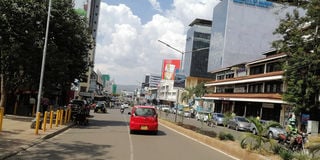Why matatus are banned from Kisumu city centre tomorrow

The car-free city plan comes after major streets in the city centre were redesigned and converted into single carriageways, a move that will also see parking areas relocated to the backstreets.
Motor vehicles and motorcycles will soon be barred from entering Kisumu’s central business district, in elaborate measures to transform the lakeside city into a non-motorised area.
The car-free city plan comes after major streets in the city centre were redesigned and converted into single carriageways, a move that will also see parking areas relocated to the backstreets.
Sidewalks have also been constructed as part of the mobility plan that will affect Oginga Odinga Street and Jomo Kenyatta Highway, while Ang’awa Avenue will be partially closed.
The project is a partnership with the Institute for Transportation and Development Policy (ITDP) and the United Nations Human Settlements Programme (UN-Habitat).
A car-free day has been slated for tomorrow (Saturday), when the three streets will be temporarily closed as part of measures aimed at making Kisumu motorists and residents aware of the new plan.
“Kisumu City management has embarked on sensitising the public on different uses of the streets and in an attempt to showcase the Kisumu Mobility Plan,” said Mr Abala Wanga, the Kisumu city manager.
Ang’awa Avenue and Jomo Kenyatta Highway have been redesigned to form the Jaramogi Oginga Odinga Triangle.
This means that all public service vehicles will not be allowed into the CBD.
Members of the public have been advised to use alternative routes to enter the city centre.
The alternative routes include Otieno Oyooo Street, Mosque Road, Kampala Street, Bank Street, and Achieng’ Oneko and Nzoia roads, which are also access points to the CBD, Milimani and other areas.
Mr Wanga said the devolved unit is ready to redesign the city to ensure that pedestrians and cyclists enjoy enhanced convenience and safety.

“Considering that a majority of residents visiting the CBD are pedestrians and cyclists, we want them to experience improved accessibility and convenience as they go arounsd their business,” he said.
Fully implemented
Launching the Kisumu car-free day and the Sustainable Mobility Plan in February this year, Governor Anyang’ Nyong’o expressed confidence that the city’s streets will be safer for pedestrians when the plan is fully implemented.
He said the CBD will be a place for walking and shopping, while vehicles entering Oginga Odinga Street will have up to 15 minutes to drop off passengers and park in the rear of the street.
Just like many other intermediary cities around the globe, Prof Nyong’o said, Kisumu’s population continues to grow, bringing a myriad of challenges.
He said the decision of the United Cities and Local Governments of Africa (UCLGA) organisers to pick Kisumu to host the ninth edition of Africities Summit will help expose the city’s potential to the international community.
“It is therefore critical for Kisumu to take advantage of every opportunity to position itself as the true African city ahead of the summit by putting into place requisite infrastructure and necessary policies and plans,” he said.
But Mr Wanga has cautioned that the City Inspectorate will not hesitate to clamp vehicles and fine offenders who take more than the allocated time.
Vehicles entering the city from Busia and Bondo routes will be required to use the Kondele or Patel roundabouts and onto the main stage through Ngumbi and Ondiek roads.
Once the project is completed early next year, the Kisumu bus stage will eventually be relocated to Nyamasaria.
He also indicated that the county will demarcate places for parking boda bodas and tuktuks to minimise disorder.





